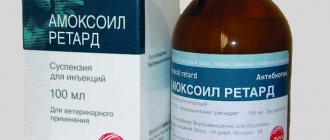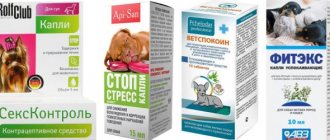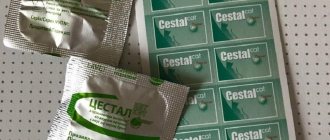Ciprovet for cats is a broad-spectrum antibiotic that has a detrimental effect on various forms of pathogenic bacteria, chlamydia, listeria. Clostridia, microscopic molds and mycoplasmas exhibit resistance to it.
The drug is available in the form of ophthalmic drops, tablets and 5% solution for intramuscular and subcutaneous injections. The advisability of using a specific form of medication, the dosage and duration of the course of therapy should be determined by a veterinary specialist, therefore independent use of Tsiprovet is undesirable.
Composition of the drug
The active component of Ciprovet for cats is ciprofloxacin, which is currently included in the list of the most effective antimicrobial agents from the group of fluoroquinolone derivatives.
The principle of this antimicrobial agent is based on the suppression of the bacterial enzyme DNA gyrase, which ensures the reading and copying of genetic information by daughter DNA molecules.
It causes:
- DNA replication disorder;
- cessation of bacterial cell growth and division;
- irreversible changes in organelles;
- destruction of the cell membrane.
The result of these processes is the rapid death of the microorganism.
Note! Cells of macroorganisms do not produce DNA gyrase, so Ciprovet does not have a harmful effect on them.
Gram-negative aerobic and anaerobic bacteria are most sensitive to ciprofloxacin, since the substance affects them both during the division period and during the resting phase.
These microbes include:
- coli;
- salmonella;
- shigella;
- Klebsiella;
- Protea and other representatives of enterobacteria;
- pseudomonas;
- Haemophilus influenzae;
- pasteurella;
- aeromonads;
- plasmidia;
- Campylobacter.
Gram-positive bacteria sensitive to antibiotics:
- staphylococci;
- streptococci;
- enterococci;
- mycobacteria.
The medicine affects them only during the division period.
Ciprofloxacin also affects intracellular parasites, the representatives of which are pathogens:
- brucellosis;
- chlamydia;
- listeriosis;
- corynebacteriosis.
Resistance to ciprofloxacin is demonstrated by:
- clostridia;
- Treponema;
- ureoplasma;
- pseudomonas.
Important! Therefore, treatment with Ciprovet for infections in cats caused by these microbes will be ineffective.
It has been established that the presented antimicrobial drug is destructive for microorganisms resistant to aminoglycosides, cephalosporins, representatives of the penicillin and tetracycline series.
After entering the animal’s gastrointestinal tract, Tsiprovet is absorbed by the epithelial cells of the small intestine, enters the blood vessels and is carried through the bloodstream to all tissues, internal organs, lymph, lacrimal and mammary glands, and the placenta.
The drug is active throughout the day, but its concentration reaches maximum values 1.5-2 hours after administration. Part of it is excreted unchanged in feces and urine, and the other part breaks down, reacts with organic compounds and leaves the body in the form of metabolites.
Important! Tsiprovet penetrates into the mammary glands and is excreted in milk during lactation. This explains the factor prohibiting the use of Ciprovet in cats while breastfeeding their offspring.
The composition of the drug, produced in the form of tablets, additionally includes lactulose, obtained artificially from milk sugar. Its beneficial effect on the functioning of the gastrointestinal tract of animals is manifested in retaining fluid in the intestinal lumen, stimulating its peristalsis, increasing the volume of feces, and improving the secretion of bile into the lumen of the duodenum. This leads to timely evacuation of feces, prevention of constipation and flatulence .
In addition, lactulose reaches the lumen of the large intestine unchanged. Here it decomposes under the influence of normal microflora, shifting the pH to the acidic side, creating unfavorable conditions for the development of pathogenic microorganisms.
Another important function of lactulose is to suppress putrefactive processes and reduce the amount of ammonia and hydrogen sulfide produced. By deoxidizing the environment, it impairs the absorption of toxic breakdown products into the blood, facilitating the functioning of the liver and kidneys.
By creating favorable conditions for the proliferation of beneficial bacteria involved in the formation of immunity, lactulose increases the cat’s body’s resistance to the effects of infectious agents.
Lactose was chosen as a filler, forming durable, non-hygroscopic tablets that do not deform or crumble during storage. This component does not affect the absorption and activity of the active substance.
Release forms of Tsiprovet for cats
For convenience and maximum effectiveness of treatment, 3 dosage forms have been developed. This allows you to influence the pathogen, both directly at the place of its localization, and on the scale of the entire cat’s body.
- Ciprovet tablets for cats , having a biconvex round shape, are coated with a yellow coating and packaged in blisters of 10 units. 1 tablet, weighing 0.2 g, contains 15 mg of active substance.
- Eye drops look like a clear, colorless liquid that may have a yellowish tint. They are produced in polymer or glass bottles with a capacity of 1, 5 and 10 cm3, placed in individual cardboard packaging.
- 5% injection solution placed in dark glass containers with a volume of 10 cm3. Each bottle is packaged in a separate cardboard box and supplied with instructions.
Note! In pharmacies there are packages of the injection solution in volumes of 20, 50, 100 and even 200 ml, designed for large animals. But since opened bottles can only be stored for 3 weeks, it is not advisable to purchase them for cats.
Composition and pharmacological properties.
Contains the active ingredient - ciprofloxacin - 100 mg/ml, and lactulose as an excipient.
Ciprofloxacin is an antibiotic of the fluoroquinolone group, has a wide spectrum of antibacterial action, is active against gram-positive and gram-negative bacteria, including Echerichia coli, Salmonella spp., Shigella spp., Klebsiella spp., Enterobacter spp., Proteus spp., Yersinia spp., Haemophilus spp., Pseudomonas aeruginosa, Pasteurella multocida, Plesiomonas shigelloides, Campylobacter jejuni, Brucella spp., Chlamydia trachomatis, Listeria monocytogenes, Mycobacterium spp., Corynebacterium diphtheriase, Staphylococcus aureus and Streptococcus spp.
Lactulose is a prebiotic and a disaccharide.
Storage conditions
Each form of Ciproveat for cats has certain differences in storage conditions.
- Ciprovet tablets can be stored for four years at a temperature range of 0 to 25°C, in a dry place, in the original packaging to prevent exposure to sunlight.
- Ophthalmic drops are stored for 3 years in a closed bottle, and no more than a month after opening it. The room temperature should be kept between 5 and 25°C.
- The 5% solution for injection retains its pharmacological characteristics for only 2 years. Once the container is opened, it can be stored for 21 days. The bottle must be placed in a dark place with a temperature of 5 to 25%.
Note! A change in the color of the tablets or liquid, the appearance of sediment or odor indicates that the drug is not suitable for use and must be disposed of.
Tsiprovet should not be stored in the refrigerator together with food. You should also avoid accidental contact with the gastrointestinal tract or the mucous membranes of a child or pet.
Description of the drug Ciprovet
Ciprovet is a broad-spectrum veterinary drug that is used to treat diseases of bacterial origin. It is produced by the Russian organization NVC Agrovetzashchita LLC (Moscow region, Sergiev Posad), which specializes in medicines, vitamins and animal care products.
"Agrovetzashchita" is a research and development center that develops and produces veterinary drugs
The manufacturer of Tsiprolet has been developing unique formulas since 1993. The organization has more than 240 products, including antibiotics that are trusted not only by animal owners, but also by veterinarians.
Release form of the drug
Ciprovet is available in three dosage forms:
- Tablets (each 0.2 g). They are covered with a yellow shell and packaged in metallized blisters of 10 pieces. Each blister is packed in a separate cardboard box along with instructions for use.
- Eye drops. It is a transparent liquid without color or with a yellowish tint. The solution is packaged in polymer or glass bottles of 10 ml. Each bottle is packed in a cardboard box.
- Solution for injection 5%. A transparent, sterile, yellow liquid, packaged in brown glass bottles (10, 20, 50, 100 or 200 ml). Each bottle is sealed with a rubber stopper, which is rolled with an aluminum cap. There are cardboard boxes of 40 or 80 bottles, but most often you can find single packs.
The bottle of Ciprovet 5% is slightly different from the packaging of other dosage forms of the drug. Thus, the label of the bottle depicts several animals, because injections with this antibiotic can be prescribed not only to cats and dogs, but also to livestock. For poultry and cattle, there is another form of release of Tsiprovet - granules packaged in 1 kg.
An inexperienced cat owner may be inattentive in a hurry. So, in an emergency situation, you can lose your vigilance and buy a fake. Real Tsiprovet, regardless of the form of release, is marked with the manufacturer’s logo: a blue sign with the inscription “AVZ”.
Original drugs from Agrovetzaschita must have the organization’s logo
Photo gallery: Ciprovet preparations for cats
Ciprovet injection solution is intended for the treatment of more complex forms of bacterial infection
Ciprovet tablets are used in the treatment of bacterial diseases
Tsiprovet eye drops have anti-inflammatory and antibacterial properties
Table: composition of the drug
| Release form | Components | Content |
| Pills | Ciprofloxacin | 15 mg in 1 tablet |
| Eye drops | Ciprofloxacin | 0,45 % |
| Benzalkonium chloride | 0,05 % | |
| Trilon B | 0,08 % | |
| Water for injections | Up to 100% | |
| Injection | Ciprofloxacin | 50 mg/ml |
| succinic acid | 10 mg/ml | |
| Trilon B | 0.5 mg/ml | |
| Water for injections | Up to 1 ml |
Storage conditions for Tsiprovet
Tsiprovet should be stored in accordance with the manufacturer's recommendations: in a dry, dark place, away from food and cat food. It is most convenient to keep the drug together with other medications intended for pets, for example, in a medicine cabinet. The ideal storage temperature is between 5 and 25°C.
It is advisable for a cat owner to have a separate first aid kit for his pet.
Please note that the shelf life depends on the form of release of the drug:
- tablets - 4 years from the date of production;
- eye drops - 3 years (store an opened bottle for no more than 30 days);
- solution for injection - 2 years (opened bottle is valid for no more than 21 days).
Indications for use
The injection solution and tablet form of Tsiprovet are prescribed after the following pathologies are detected:
- gastrointestinal diseases caused by pathogenic bacteria;
- infectious lesions of the liver and biliary system;
- diseases of the respiratory and genitourinary systems caused by bacterial microflora;
- inflammation and degenerative changes in cartilage and joints caused by infectious agents;
- purulent inflammation of the skin (abscesses, cellulitis, boils);
- infected wounds and postoperative sutures;
- secondary bacterial infections against the background of viral diseases, dermatitis, injuries, postoperative complications, etc.
In gynecological practice, this drug is used to treat metritis, endometritis, postpartum septicemia, and mastitis.
Important! During the period of antibacterial therapy, puppies are separated from the female and transferred to artificial feeding. This is a necessity, as it helps prevent infection of the offspring and speed up the recovery of the cat’s body.
Indications for the use of eye drops are:
- bacterial and chlamydial conjunctivitis;
- blepharitis;
- keratitis;
- inflammation of the eyelids, cornea or iris of a bacterial nature;
- ulcers formed on the cornea of the eye as a result of the activity of pathogenic microflora;
- damage to the organs of vision by mechanical, thermal or chemical agents.
Ophthalmic drops are prescribed before surgery in the eye area, as well as in the postoperative period to prevent infection of the wound surface.
Note! Before starting treatment, a very important factor is making an accurate diagnosis and determining the nature of the disease. This is explained by the fact that antibacterial therapy is powerless against pathologies caused by viruses and protozoa.
Instructions for use of Tsiprovet
When starting a therapeutic course, you should understand that its effectiveness largely depends on compliance with the instructions for use of Tsiprovet. Therefore, it is necessary to strictly follow the scheme developed by a veterinarian after examining the animal and obtaining laboratory results (if necessary).
Pills
You can make the task of feeding your cat Tsiprovet tablets easier by thoroughly crushing them and mixing them with a small amount of your favorite treat. The neutral taste of the drug will not change the taste characteristics of the food, so it will be easily eaten even by picky pets.
The main feeding should be carried out no earlier than 20 minutes after using the antibiotic.
Eye drops
Most ophthalmological diseases are accompanied by the release of purulent or bloody exudate, resulting in the formation of dried or weeping crusts on the eyes.
Before using eye drops, these contaminants must be removed with a clean gauze swab moistened with a weak antiseptic or Tsiprovet solution.
Important! If the doctor has prescribed several eye medications, at least five minutes should pass between each use.
Doses and procedure for using Tsiprovet eye drops in veterinary medicine
Ciprovet eye drops are instilled according to the instructions for use.
into the conjunctival cavity of the affected eye of animals, 1–2 drops four times a day for 7–14 days until clinical recovery. If there is abundant purulent or mucopurulent discharge, instill 3-4 drops of the drug, then carefully remove all discharge and crusts with a gauze swab. After this, 1-2 drops of the drug are instilled.
CIPROVET should be administered to animals at the following intervals, even at night:
The drug must be dripped more often than indicated in the instructions for use. On the first day, place 2 drops into the affected eye every 15 minutes for the first six hours, then 2 drops into the affected eye every 30 minutes for the rest of the day.
On the second day, instill 2 drops into the affected eye every hour.
From the third to the fourteenth day, apply two drops to the affected eye every 4-6 hours.
Dosage of the drug
The manufacturer's recommended dosage of Ciprovet tablets for cats is 1 tablet per 3 kg of live weight of the animal. However, the veterinarian can make adjustments based on the physiological state of the animal. The maximum duration of treatment is 5 days.
Tsiprovet ophthalmic drops are used 4 to 8 times a day, depending on the severity of the lesion. To do this, apply 1 drop to the area of the lacrimal sac of both eyes of the cat.
Note! This procedure is unpleasant, so the cat will try to avoid it and escape from the owner’s hands. To protect yourself from getting scratches and bites, you should carry out this manipulation together, when one person firmly fixes the animal, and the other applies the drug.
The course of treatment is from 1 to 2 weeks. The indicator is the complete absence of clinical symptoms of the disease for 2-3 days. If relapses occur, treatment is repeated according to the same scheme.
A 5% solution for injection is used in cases of severe septic form of the pathology, as well as when it is impossible to feed the tablet form of the drug. The dosage is 1 cm3 per 10 kg of cat’s live weight once a day. The course of therapy should not exceed 5 days.
The injection solution can be administered subcutaneously and intramuscularly, using sterile instruments and following all antiseptic rules.
Features of use in cats
The treatment regimen, drug form and dosage are prescribed by the veterinarian. Features of use depend on the purpose of using the antibiotic, as well as on the dosage form of Tsiprovet.
Most people I know make treatment decisions without consulting a veterinarian. This is usually done like this: the disease is determined by symptoms without tests, and then a medicine is selected. Treat the cat as advised on the forums. When it turns out that the medicine does not help, and the animal has become worse, the unfortunate owners go to the veterinary clinic, and their diagnosis is not confirmed. Of course, such sad results do not always happen, but it is not advisable to risk the life and health of your pet.
Use of tablets
Ciprovet tablets are used in cats once a day for 3–5 days. The dosage is selected based on the pet’s weight - 1 tablet per 3 kg of body weight. That is, if an animal weighs 4.5 kg, then it needs 1.5 tablets per day.
Video: how to give a pill to a cat
Features of using drops
Ciprovet eye drops are instilled into the affected eye, 1 drop at a time. The medicine should be used for 1 to 2 weeks, depending on the dynamics and complexity of the disease. If no improvement is observed after instillation, Tsiprovet can be replaced with another drug (usually veterinarians recommend changing the drops after 10 days of use if there is no positive dynamics).
If your cat's eyes are pus-filled or watery, but mucus is forming in the corners of the eyes, you will need to remove the discharge first. To do this, you need to drip 3-4 drops of Tsiprovet, remove all dirt with a sterile gauze cloth, and then drip a therapeutic dose - 1-2 drops.
Tsiprovet drops may cause a slight burning sensation (the cat will try to rub its eyes), you should not be afraid of this.
Video: how to drop medicine into a cat’s eyes
Tsiprovet injections
Ciprovet 5% is injected into the muscle or subcutaneously once a day for 3–5 days. The dosage depends on the cat’s body weight - 1 ml per 10 kg of weight.
It is difficult to divide a milliliter into several injections, so owners often exceed the recommended dosage. This is not critical, but the maximum daily dose of the solution should not be more than 1 ml.
It is not difficult to make a subcutaneous or intramuscular injection; for this you need to correctly determine the injection site. For subcutaneous administration, it is convenient to choose a place on the cat’s withers (the area between the back of the head and the shoulder blades). It is more convenient to give an intramuscular injection in the back of the hind limb (the fleshiest place on the leg). Here is a sample action plan:
- Draw the solution into the syringe without touching the needle.
- Release air bubbles from the syringe (a drop of medicine should appear at the tip of the needle).
- Secure the cat so that it cannot escape (you can ask household members to help).
- If the injection site is the withers, then you need to make a small fold with your thumb and forefinger.
- Insert the needle smoothly at an angle of 90 degrees to a depth of 1–1.5 cm.
- Introduce the drug without sudden movements (any movement of the needle in the tissues will cause pain).
- Pull out the needle and calm the animal.
- There is no need to rub the injection site.
The figure highlights the places that are most often used for injections.
Features of use in pregnant cats and kittens
It is not recommended to use Tsiprovet for the treatment of kittens, at least until the animal stops growing. It is believed that ciprofloxacin can affect the growth and development of a small organism, but veterinarians sometimes prescribe Ciprovet to kittens, for example, in the form of drops (if the threat to life is greater than the risk of negative consequences).
Ciprovet is also not recommended for pregnant cats. The antibiotic will definitely reach the future kittens, and this is dangerous for their lives. Ciprovet should not be given to nursing cats either.
Side effects
Side effects of using Tsiprovet that occur as a result of an overdose or individual intolerance to the drug include:
- vomit;
- diarrhea;
- lameness;
- refusal to feed or loss of appetite;
- skin rashes;
- itching;
- swelling or tenderness at the injection site, which goes away within 1-3 days.
If, after using the medicine, your pet experiences a fever, difficulty breathing, or nervous symptoms, you should immediately give him an antihistamine and contact the clinic.
The use of eye drops may cause short-term redness and a burning sensation lasting no more than 5-10 minutes.
If your cat experiences excessive lacrimation, increasing itching, hyperemia or swelling, then you should stop using the product and give an antihistamine to neutralize the allergy symptoms.
Ciprovet eye drops 10ml
DESCRIPTION
Ciprovet – eye drops for the treatment and prevention of ophthalmic diseases of bacterial etiology in dogs and cats. In appearance, the drug is a transparent, colorless or light yellow liquid.
COMPOUND
The drug as an active ingredient contains ciprofloxacin hydrochloride - 0.45% and excipients: benzalkonium chloride - 0.05%, Trilon B - 0.08% and water for injection - up to 100%.
PHARMACOLOGICAL PROPERTIES
Ciprovet eye drops are an antibacterial anti-inflammatory drug for topical use in ophthalmology.
Ciprofloxacin hydrochloride, which is part of the drug, has a bactericidal effect on most gram-positive and gram-negative microorganisms, incl. chlamydia, mycoplasma, Staphylococcus aureus and Pseudomonas aeruginosa, including strains of microorganisms resistant to methicillin and gentamicin.
The mechanism of action of ciprofloxacin hydrochloride is the inhibition of bacterial DNA gyrase (topoisomerase) - X enzyme, destruction of the DNA structure and disruption of the bacterial cell membrane, which leads to the death of bacteria.
When applied topically, ciprofloxacin penetrates well into the cornea and the anterior chamber of the eye, especially when the epithelial layer of the cornea is damaged.
Ciprovet eye drops, in terms of the degree of impact on the body, are classified as low-hazard substances (hazard class 4 according to GOST 12.1.007-76), in recommended doses they do not have a local irritant or resorptive toxic effect.
DOSAGE AND APPLICATION
Ciprovet eye drops are prescribed to dogs and cats for the following ophthalmological indications: for therapeutic purposes in acute and chronic conjunctivitis, keratoconjunctivitis, keratitis, corneal ulcers, septic iridocyclitis, blepharitis; for the purpose of preventing infectious eye diseases after injuries and foreign bodies, as well as in eye surgery during the preoperative and postoperative periods.
If there is abundant purulent or mucopurulent discharge, a hygienic treatment of the eye is first carried out - 3-4 drops of the drug are instilled and the exudate is removed with a sterile gauze swab. After this, 1-2 drops of the drug are instilled and treatment is carried out.
If necessary, the course of treatment is repeated.
SPECIAL INSTRUCTIONS
The drug should not be used in kittens and puppies under 7 days of age.
Drops should be used with caution in animals with cerebral atherosclerosis and cerebrovascular accident.
If one or more doses of the drug are missed, the course of use must be resumed as soon as possible in the prescribed dosages and regimen.
Ciprovet eye drops are incompatible with drug solutions with a pH value of 3-4, which are physically or chemically unstable. When using other ophthalmic drugs, the interval between their administration should be at least 5 minutes.
Ciprovet eye drops are not intended for use in productive animals.
CONTRAINDICATIONS
A contraindication to the use of Tsiprovet eye drops is the increased individual sensitivity of the animal to fluoroquinolones.
SIDE EFFECTS
When using the drug in accordance with these instructions, side effects and complications, as a rule, are not observed. In rare cases, the drug may cause mild soreness and hyperemia of the conjunctiva, itching, and lacrimation, which disappear within 5 minutes.
If allergic reactions occur in animals (conjunctival hyperemia continues or increases), the use of the drug is stopped.
SHELF LIFE AND STORAGE
Store Ciprovet eye drops in the manufacturer's sealed packaging, protected from light and moisture, separately from food and feed, at a temperature of 5°C to 25°C.
The shelf life of the medicinal product, subject to storage conditions, is 3 years from the date of production; after opening the bottle – 30 days.
PACKAGE
Ciprovet drops are produced packaged in polyethylene or glass bottles, packed individually in a cardboard box.
Contraindications
The following contraindications exist for the use of Tsiprovet tablets and solution for injection:
- individual immunity;
- period of gestation and breastfeeding;
- age up to 6 months;
- nervous phenomena (convulsions, paralysis);
- degenerative changes in cartilage and bone tissue;
- dysfunction of the liver and kidneys.
It is prohibited to use Tsiprovet in combination with other antibiotics, drugs containing metal ions, and non-steroidal anti-inflammatory drugs.
Eye drops have significantly fewer contraindications. They should not be used if there is increased sensitivity to the components of the drug and if the cat has pathologies of cerebral circulation.
Analogues of Tsiprovet for cats
Analogues of Ciprovet can be considered drugs whose active ingredient is ciprofloxacin. From the extensive list we can highlight eye drops:
- Tsifran;
- Ciprolone;
- Tsiprolet;
- Phloximed;
- Tsipromed.
Analogues of Tsiprovet, produced in the form of solution and tablets, include:
- Cypronate;
- Tsiprosil;
- Ciprobid;
- Ciprosol;
- Ciprodox;
- Tsipraz and others.
Important! Replacing Tsiprovet with its analogue must be agreed upon with a veterinary specialist.










